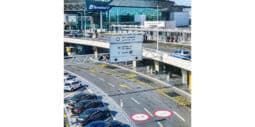

24786 views
Written by: Kate Zusmann

| Opening Hours |
Sunday:
-
Monday:
-
Tuesday:
-
Wednesday:
-
Thursday:
-
Friday:
-
Saturday:
-
|
|---|---|
| Address | Piazza S. Ignazio, Roma |
The Church of St. Ignatius of Loyola in Rome ( Chiesa di Sant’Ignazio di Loyola in Campo Marzio) is a magnificent Baroque masterpiece known for its ornate beauty and unique architectural features.
Built in the 17th century, the Church was designed by prominent architects, including Carlo Maderno and Francesco Grimaldi. Its stunning interior is adorned with intricate frescoes, trompe-l’oeil elements, and an iconic ceiling featuring a painting of the Apotheosis of St. Ignatius by Andrea Pozzo.
Contents
ToggleThe Church of St. Ignatius of Loyola, commonly known as the Chiesa di Sant’Ignazio, is a Jesuit church dedicated to the founder of the Jesuit order, St. Ignatius of Loyola. The Church’s history traces back to the early 17th century when the Jesuits sought to establish a grand church in honor of their founder. The construction began in 1626 under the supervision of the architect Carlo Maderno, who worked on the Church’s early designs until he died in 1629.
Upon Maderno’s death, the project was taken over by Francesco Grimaldi, who made significant alterations to the original plans. The Church was consecrated in 1650, although some parts of the structure were still incomplete. One of the outstanding features of the Church is its unique architectural design, notably the use of forced perspective in the nave, an optical illusion that creates the appearance of a much larger space than the Church’s actual dimensions.
The Church of St. Ignatius is renowned for its elaborate interior decoration. The ceiling of the nave, created by Andrea Pozzo, is particularly noteworthy. The ceiling gives the illusion of a dome, despite the actual absence of one, and features a magnificent fresco depicting the Apotheosis of St. Ignatius. The Church also houses numerous chapels adorned with exquisite Baroque art, including sculptures by Pierre Legros and paintings by Andrea Sacchi.
One of the most notable aspects of the Church’s history occurred in the mid-18th century when, due to financial constraints, the Jesuits could not complete the dome’s construction. To address this, a false dome, known as the “eye-deceiving cupola,” was painted on the ceiling by Andrea Pozzo. This illusionistic technique effectively created the appearance of a dome without the need for a physical structure.
Despite its incomplete dome, the Church of St. Ignatius of Loyola is a splendid example of Roman Baroque architecture. It remains an important religious and cultural landmark in the heart of Rome. It attracts visitors from around the world who come to marvel at its artistic treasures and the architectural ingenuity employed to create a visually stunning interior. Today, hundreds of visitors come to take a selfie in the mirror inside the Church of St. Ignatius with the paintings from the ceiling in the background.
The Church of Sant’Ignazio di Loyola in Rome is a treasure trove of Baroque art and architectural marvels. Here are some notable features to see:
Read also about the Pantheon in Rome, located within a 5-minute walk from the Sant’Ignazio church.
Saint Ignatius of Loyola, born Íñigo López de Loyola in 1491, was a Spanish Basque priest and theologian who became the founder of the Society of Jesus, commonly known as the Jesuits. Ignatius was a crucial figure in the Catholic Counter-Reformation and played a significant role in reviving and strengthening the Catholic Church during religious upheaval.
Ignatius underwent a profound religious conversion while recovering from a battle injury in 1521. During his recovery, he devoted himself to prayer and study, formulating the Spiritual Exercises—a set of meditations, prayers, and mental exercises designed to deepen one’s relationship with God. These exercises later became a cornerstone of Jesuit spirituality.
In 1540, Ignatius received papal approval for the Society of Jesus, an order of clerics and laypersons dedicated to education, missionary work, and service to the Church. The Jesuits became known for their worldwide commitment to scholarship, education, and missionary activities.
Saint Ignatius of Loyola was canonized by Pope Gregory XV in 1622, and his feast day is celebrated on July 31st. He is often depicted in religious art with a book, representing his Spiritual Exercises, and a flaming heart, symbolizing his genuine love for God. Saint Ignatius is recognized as a religious leader and a prominent figure in Christian mysticism and contemplative prayer.
Read also about the guide to Borromini’s masterpieces in Rome.
Author: Kate Zusmann
This website uses cookies. For more info read the cookies policy
Rome.us © 2025. Created with love by Roman experts and guides.